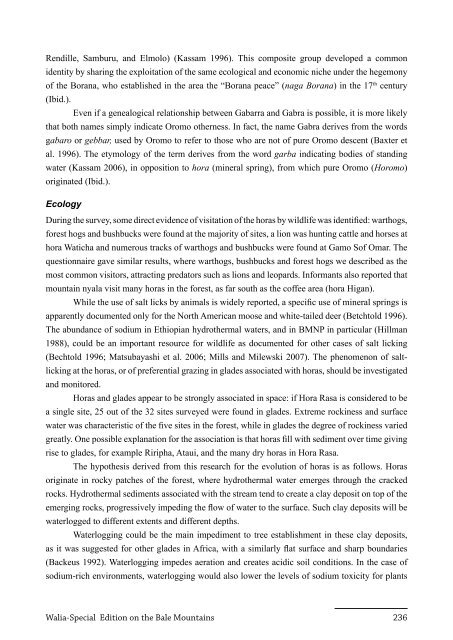Walia Special Edition on the Bale Mountains (2011) - Zoologische ...
Walia Special Edition on the Bale Mountains (2011) - Zoologische ...
Walia Special Edition on the Bale Mountains (2011) - Zoologische ...
Create successful ePaper yourself
Turn your PDF publications into a flip-book with our unique Google optimized e-Paper software.
Rendille, Samburu, and Elmolo) (Kassam 1996). This composite group developed a comm<strong>on</strong><br />
identity by sharing <strong>the</strong> exploitati<strong>on</strong> of <strong>the</strong> same ecological and ec<strong>on</strong>omic niche under <strong>the</strong> hegem<strong>on</strong>y<br />
of <strong>the</strong> Borana, who established in <strong>the</strong> area <strong>the</strong> “Borana peace” (naga Borana) in <strong>the</strong> 17th century<br />
(Ibid.).<br />
Even if a genealogical relati<strong>on</strong>ship between Gabarra and Gabra is possible, it is more likely<br />
that both names simply indicate Oromo o<strong>the</strong>rness. In fact, <strong>the</strong> name Gabra derives from <strong>the</strong> words<br />
gabaro or gebbar, used by Oromo to refer to those who are not of pure Oromo descent (Baxter et<br />
al. 1996). The etymology of <strong>the</strong> term derives from <strong>the</strong> word garba indicating bodies of standing<br />
water (Kassam 2006), in oppositi<strong>on</strong> to hora (mineral spring), from which pure Oromo (Horomo)<br />
originated (Ibid.).<br />
Ecology<br />
During <strong>the</strong> survey, some direct evidence of visitati<strong>on</strong> of <strong>the</strong> horas by wildlife was identified: warthogs,<br />
forest hogs and bushbucks were found at <strong>the</strong> majority of sites, a li<strong>on</strong> was hunting cattle and horses at<br />
hora Waticha and numerous tracks of warthogs and bushbucks were found at Gamo Sof Omar. The<br />
questi<strong>on</strong>naire gave similar results, where warthogs, bushbucks and forest hogs we described as <strong>the</strong><br />
most comm<strong>on</strong> visitors, attracting predators such as li<strong>on</strong>s and leopards. Informants also reported that<br />
mountain nyala visit many horas in <strong>the</strong> forest, as far south as <strong>the</strong> coffee area (hora Higan).<br />
While <strong>the</strong> use of salt licks by animals is widely reported, a specific use of mineral springs is<br />
apparently documented <strong>on</strong>ly for <strong>the</strong> North American moose and white-tailed deer (Betchtold 1996).<br />
The abundance of sodium in Ethiopian hydro<strong>the</strong>rmal waters, and in BMNP in particular (Hillman<br />
1988), could be an important resource for wildlife as documented for o<strong>the</strong>r cases of salt licking<br />
(Bechtold 1996; Matsubayashi et al. 2006; Mills and Milewski 2007). The phenomen<strong>on</strong> of saltlicking<br />
at <strong>the</strong> horas, or of preferential grazing in glades associated with horas, should be investigated<br />
and m<strong>on</strong>itored.<br />
Horas and glades appear to be str<strong>on</strong>gly associated in space: if Hora Rasa is c<strong>on</strong>sidered to be<br />
a single site, 25 out of <strong>the</strong> 32 sites surveyed were found in glades. Extreme rockiness and surface<br />
water was characteristic of <strong>the</strong> five sites in <strong>the</strong> forest, while in glades <strong>the</strong> degree of rockiness varied<br />
greatly. One possible explanati<strong>on</strong> for <strong>the</strong> associati<strong>on</strong> is that horas fill with sediment over time giving<br />
rise to glades, for example Riripha, Ataui, and <strong>the</strong> many dry horas in Hora Rasa.<br />
The hypo<strong>the</strong>sis derived from this research for <strong>the</strong> evoluti<strong>on</strong> of horas is as follows. Horas<br />
originate in rocky patches of <strong>the</strong> forest, where hydro<strong>the</strong>rmal water emerges through <strong>the</strong> cracked<br />
rocks. Hydro<strong>the</strong>rmal sediments associated with <strong>the</strong> stream tend to create a clay deposit <strong>on</strong> top of <strong>the</strong><br />
emerging rocks, progressively impeding <strong>the</strong> flow of water to <strong>the</strong> surface. Such clay deposits will be<br />
waterlogged to different extents and different depths.<br />
Waterlogging could be <strong>the</strong> main impediment to tree establishment in <strong>the</strong>se clay deposits,<br />
as it was suggested for o<strong>the</strong>r glades in Africa, with a similarly flat surface and sharp boundaries<br />
(Backeus 1992). Waterlogging impedes aerati<strong>on</strong> and creates acidic soil c<strong>on</strong>diti<strong>on</strong>s. In <strong>the</strong> case of<br />
sodium-rich envir<strong>on</strong>ments, waterlogging would also lower <strong>the</strong> levels of sodium toxicity for plants<br />
<str<strong>on</strong>g>Walia</str<strong>on</strong>g>-<str<strong>on</strong>g>Special</str<strong>on</strong>g> <str<strong>on</strong>g>Editi<strong>on</strong></str<strong>on</strong>g> <strong>on</strong> <strong>the</strong> <strong>Bale</strong> <strong>Mountains</strong> 236
















